by Susan Flantzer © Unofficial Royalty 2018

Peter I (the Great), Emperor of All Russia; Credit – Wikipedia
In 1669, Maria Ilyinichna Miloslavskaya, the wife of Alexei I, Tsar of All Russia, died due to childbirth complications following the birth of her thirteenth child who also died. The death of Tsar Alexei’s heir 15-year-old Tsarevich Alexei in January 1670, so soon after his wife’s death, was especially difficult for the Tsar because his only surviving sons were Feodor, who was disabled by an unknown disease that left him disfigured and partially paralyzed, and Ivan, who had serious physical and mental disabilities. On February 1, 1671, Alexei married 19-year-old Natalya Kyrillovna Naryshkina, hoping his second marriage would give him a healthy son to continue the fledgling Romanov dynasty, and it did – a son who is now known as Peter the Great.
Peter I (the Great), Emperor of All Russia (Pyotr Alexeievich) was the eldest of the three children of Alexei I, Tsar of All Russia, the second ruler of the Romanov dynasty, and his second wife Natalya Kyrillovna Naryshkina. Named after the apostle St. Peter, he was born at the Moscow Kremlin on June 9, 1672. The infant was robust and healthy, not like the sickly sons of Alexei’s first marriage.
Peter had two siblings:
- Tsarevna Natalya Alexeievna (1673–1716), unmarried, a playwright and founder of the first public theater in Russia
- Tsarevna Fyodora Alexeievna (1674–1677)
Peter had thirteen half-siblings from his father’s first marriage to Maria Ilyinichna Miloslavskaya but at the time of his birth in 1672, only eight were living. None of Peter’s sisters married. They lived their lives in isolation in the terem, separate living quarters, and were prevented from socialization with men outside their immediate family.
- Tsarevich Dmitri Alexeievich (1648–1649); died in infancy
- Tsarevna Yevdokia Alekseevna (1650–1712)
- Tsarevna Marfa Alexeievna (1652–1707)
- Tsarevich Alexei Alexeievich (1654–1670); died unmarried, age 15
- Tsarevna Anna Alexeievna (1655–1659); died in infancy
- Tsarevna Sofia Alexeievna (1657–1704), Regent of Russia (1682–89) for her two younger brothers Ivan V and Peter I; unmarried
- Tsarevna Ekaterina Alexeievna (1658–1718)
- Tsarevna Maria Alexeievna (1660–1723)
- Feodor III, Tsar of All Russia (1661–1682); succeeded his father as Tsar of Russia; married (1) Agaphia Simeonovna Gruszewska, no surviving children (2) Marfa Matveievna Apraksina, no children
- Tsarevna Feodosia Alexeievna (1662–1713)
- Tsarevich Simeon Alexeievich (1665–1669); died in infancy
- Ivan V, Tsar of All Russia (1666–1696); was co-ruler along with his younger half-brother Peter I; married Praskovia Feodorovna Saltykova, had five daughters including Anna, Empress of All Russia
- Tsarevna Yevdokia Alexeevna (1669–1669)
Alexei did not expect his sickly sons from his first marriage, Feodor and Ivan, to survive him. Only 43 years old at the time of Peter’s birth, Alexei expected to reign for many more years before Peter would come to the throne. However, on February 9, 1676, five years after marrying Natalya Kyrillovna Naryshkina, Alexei I, Tsar of All Russia died of a heart attack at the age of 46.
Alexei was succeeded by 15-year-old Feodor III, his eldest surviving son from his first marriage. Even though Feodor was well educated and had a fine intellect, his debilitating physical condition prevented him from fully participating in reigning. Throughout Feodor’s reign, the government was largely run by Artamon Sergeyevich Matveev, who had raised Natalya Kirillovna and had become a close friend of her husband Alexei.
While Natalya Kyrillovna Naryshkina was married to Tsar Alexei, her family held powerful positions. However, with a new Tsar who was the son of Alexei’s first wife Maria Ilyinichna Miloslavskaya, the Miloslavsky family came back to power. Feodor III held no ill feelings against his stepmother and his half-siblings but Natalya knew her son Peter was the Naryshkin family’s hope for the future and feared for his safety. As time progressed, Natalya realized that Peter was still an important figure and that Feodor III was also kind and sympathetic towards them. Natalya and her children faded from public view remaining cloistered in the Moscow Kremlin.

Peter as a child; Credit – Wikipedia
Peter had started his education while his father was still alive, learning the alphabet and numbers. When he was five years old, Peter was given a tutor, Nikita Moiseevich Zotov. Historians differ regarding the quality of Zotov’s teaching but he remained a lifelong friend of Peter. Although initially asked to teach reading and writing, Zotov found Peter curious and interested in many things. Peter asked for lessons on Russian history, battles, and heroes. At Zotov’s request, Peter’s mother ordered engravings of foreign cities and palaces, sailing ships, weapons, and historical events. Zotov placed them in Peter’s classroom, along with a globe. Other tutors and experts instructed Peter in royal and military history, blacksmithing, carpentry, printing, sailing, and shipbuilding – all subjects Peter wanted to learn. His tutor Nikita Moiseevich Zotov stimulated his curiosity and facilitated his learning. Peter chose what he wanted to learn and, in effect, became a self-made man.
Feodor III, Tsar of All Russia had married twice but he had no surviving children and died on May 7, 1682, at the age of 20. Feodor’s death triggered the Streltsy Uprising of 1682, a struggle for the succession between the families of the two wives of Alexei I. Feodor was followed next in the line of succession by his only surviving full brother, the 15-year-old Ivan, who had serious physical and mental disabilities but nevertheless, was the choice of the Miloslavsky family to become Tsar. The family of Natalya Kirillovna Naryshkina, instead wanted the healthy ten-year-old Peter to succeed. The Boyar Duma, a council of Russian nobles, chose Peter to become Tsar of All Russia with his mother as regent.
To protect Ivan’s interests, Sophia Alexeievna, Alexei’s eldest surviving daughter from his first marriage and Ivan’s sister, led a rebellion of the Streltsy, an elite military corps, in April – May 1682. During the rebellion, some of Peter’s relatives and allies were murdered, including two of his maternal uncles and his father’s good friend Artamon Sergeyevich Matveev. The young Peter witnessed some of these violent acts.
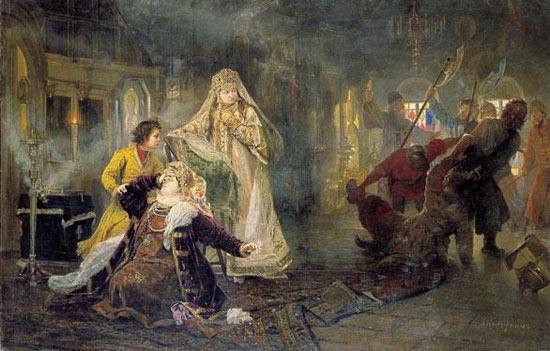
Ivan Naryshkin, Natalya’s brother, is dragged out of the palace while Peter I consoles his mother and Sophia watches with satisfaction; Credit – Wikipedia
The rebellion made it possible for Sophia Alexeevna, her maternal family the Miloslavskys, and their allies to insist that Peter and Ivan be proclaimed joint Tsars, with Ivan being the senior Tsar. Although Ivan was called the senior Tsar, he never directly dealt with government affairs due to his disabilities. He did, however, participate in ceremonies. On June 25, 1682, Ivan V and Peter I were crowned in the Assumption Cathedral in the Moscow Kremlin.

Coronation of Ivan V and Peter I; Credit – Wikipedia
Sophia acted as regent during the minority of Ivan and Peter. During this time, Natalya Kirillovna received her only financial support from the Patriarch of the Russian Orthodox Church and lived away from the court, at Tsar Alexei’s former summer residence in Preobrazhenskoye near Moscow.
In 1689, 17-year-old Peter overthrew his half-sister Sophia Alexeevna. Peter I and Ivan V continued as co-tsars, and Sophia was forced to enter a convent and give up her position as a member of the royal family. Because of his young age, Peter could not acquire actual control over Russian affairs. Instead, the power was controlled by his mother and her brother Lev Naryshkin who was appointed the minister of foreign affairs and was the de facto prime minister. It was not until his mother died in 1694 and his half-brother’s death in 1696 that Peter assumed complete authority.
In 1689, at the insistence of his mother, Peter married Eudoxia Feodorovna Lopukhina, the last ethnic Russian and non-foreign wife of a Russian monarch. Eudoxia was brought up staunchly Russian Orthodox, basically uneducated, and with a strong dislike of anything foreign. Her future husband Peter I was the complete opposite. Peter’s mother Natalya Kyrillovna Naryshkina thought if the 17-year-old Peter married, he would settle down, and turn from an adolescent into a man.
Peter accepted his mother’s will without argument but had minimal interest in the marriage plans. He agreed to the traditional bride-show but he decided instead of him, his mother would choose his bride from among the young women assembled. Once his mother had chosen Eudoxia Feodorovna Lopukhina, Peter made no complaint and the couple was married on January 27, 1689.

Eudoxia Feodorovna Lopukhina; Credit – Wikipedia
The marriage was a disaster from the start, although within two years, Eudoxia had given birth to two sons, however, the second son died after seven months. By that time, Peter was so estranged from Eudoxia that he did not even attend his son’s funeral. Peter had abandoned his wife for a mistress, Anna Mons, the daughter of a Dutch wine merchant. Their relationship lasted for twelve years until Peter met Marta Samuilovna Skavronskaya, first his mistress, then his second wife renamed Catherine (Ekaterina) Alexeievna, and finally his successor on the Russian throne as Catherine I, Empress of All Russia. In 1698, Peter forced Eudoxia to become a nun, freeing himself from the unsuccessful marriage.
Peter and Eudoxia had two sons but only the eldest survived infancy.
-
- Alexei Petrovich, Tsarevich of Russia (1690 – 1718), married Charlotte Christine of Brunswick-Lüneburg, had two children: Grand Duchess Natalya Alexeievna and Peter II, Emperor of All Russia; both children died in their teens and Charlotte Christine died of childbirth complications a few days after the birth of her son
- Alexander Petrovich (1691 – 1692)
Peter was an imposing person, both personally and physically. He grew to be exceptionally tall, 6 feet 8 inches (203 cm), and implemented sweeping reforms aimed at modernizing Russia. His reforms and ideas have had a lasting effect on Russia. During his lifetime, “the Great” was added to his titles.
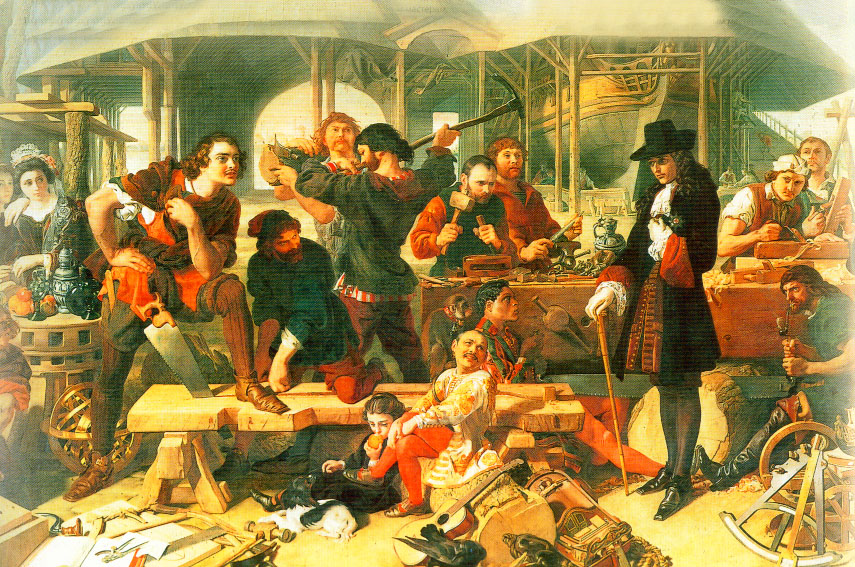
Peter (on the left) building ships in the Netherlands; Credit – Wikipedia
In 1697, Peter traveled incognito to Western Europe on an 18-month tour called the “Grand Embassy”. He used a pseudonym, allowing him to escape social and diplomatic events but since he was far taller than most others, he did not fool anyone of importance. In the Netherlands, he studied shipbuilding which he later used to build the Russian navy. In England, Peter met with King William III, visited Greenwich and Oxford, posed for artist Sir Godfrey Kneller, and saw a Royal Navy Fleet Review. He traveled to Manchester to learn the techniques of city-building which he would later use to found the city of St. Petersburg.

Kneller’s portrait of Peter, a gift to King William III of England; Credit – Wikipedia
Peter’s modernization reforms included:
- Reorganizing the Russian army along modern lines
- Establishing a Russian navy
- Introducing French and Western dress to his court
- Requiring courtiers, state officials, and the military to shave their beards and adopt modern clothing styles
- Made calendar adjustments to be in line with Western Europe
- Reorganized government agencies
- Succession decree stating that the reigning emperor appoints a successor during his lifetime and that anyone may be named as his heir – in effect until the reign of Paul I
- Created a new order of precedence known as the Table of Ranks
- Compulsory education for 10- to 15-year-old children of the nobility, government clerks, and lesser-ranked officials
- The first Russian newspaper was founded and translations of many books into Russian appeared
- Abolished the land tax and household tax and replaced them with a poll tax
- Reformed the Russian Orthodox Church administration
- Founded schools of higher education: a school of mathematical and navigational sciences, artillery, engineering, and medical schools, and a naval academy
- 4,500 new words were added to the Russian language, borrowed from European languages
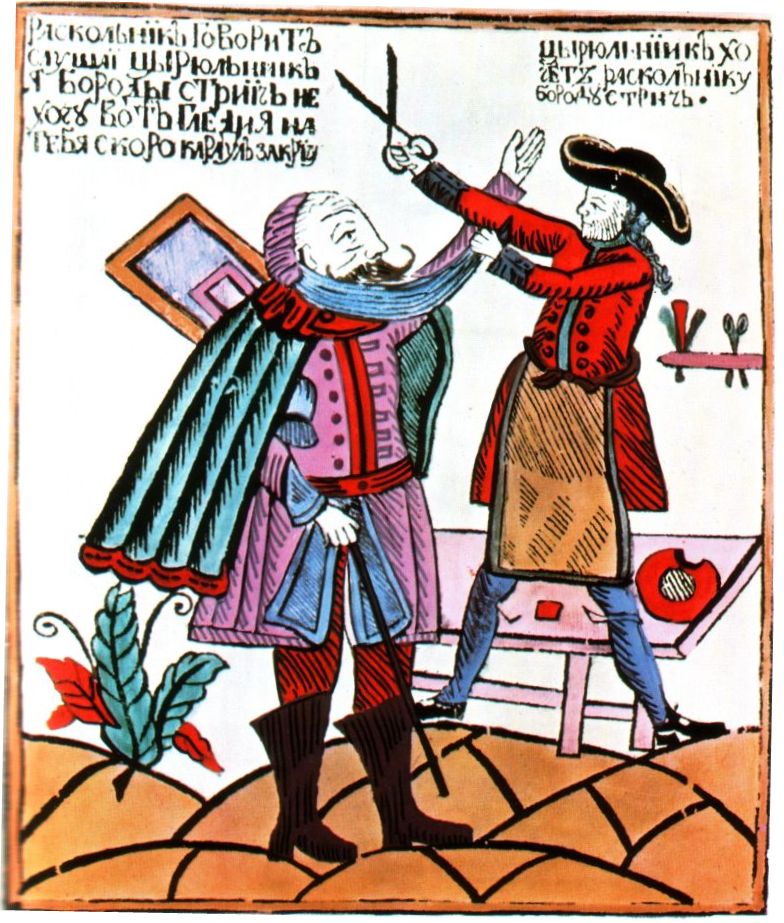
Forcible beard shaving; Credit – Автор: неизвестен – неизвестен, Общественное достояние, https://commons.wikimedia.org/w/index.php?curid=3741279
In 1703, Peter met 19-year-old Marta Samuilovna Skavronskaya, born Marta Helena Skowrońska, the Polish widow of a soldier. Marta has a sketchy early background. After her town was invaded by the Russian army, Marta, a maid or mistress of the Russian general, traveled back to the Russian court with the army. She became part of the household of Prince Alexander Menshikov, Peter’s best friend. Peter met Marta while visiting Menshikov. By 1704, Marta was well established in Peter’s household as his mistress and given birth to a son. In 1705, she converted to Russian Orthodoxy from Roman Catholicism and took the name of Catherine (Ekaterina) Alexeievna. Although no official record exists, Peter and Catherine secretly married between October 23 and December 1, 1707, in St. Petersburg. They married publicly on February 19, 1712, at St. Isaac’s Cathedral in St. Petersburg. Their daughters Anna and Elizabeth were the bridal attendants.
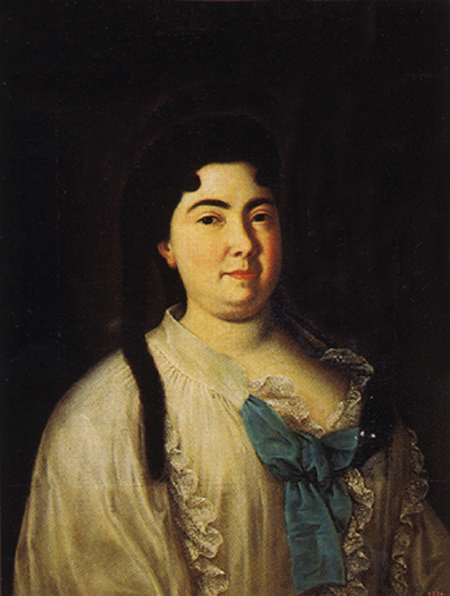
Peter’s second wife Catherine Alexeievna; Credit – Wikipedia
Catherine and Peter had twelve children, all of whom died in childhood except Anna and Elizabeth:
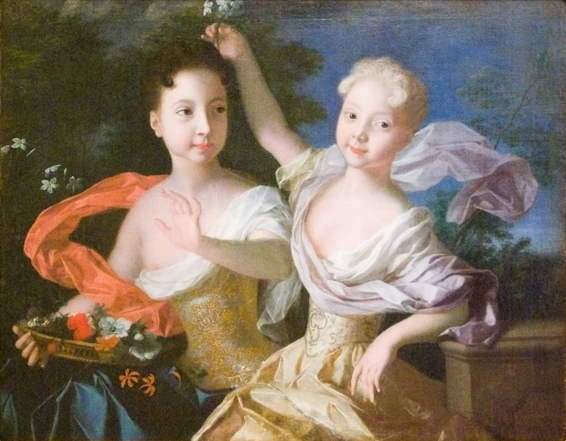
Peter’s daughters Anna and Elizabeth; Credit – Wikipedia
-
- Pyotr Petrovich born 1704, died in infancy
- Pavel Petrovich born 1705, died in infancy
- Catherine Petrovna (1706 – 1708)
- Grand Duchess Anna Petrovna (1708 – 1728), married Karl Friedrich, Duke of Holstein-Gottorp, had one son Carl Peter Ulrich, the future Peter III, Emperor of All Russia, Anna died of childbirth complications
- Elizabeth, Empress of All Russia (1709 – 1762), unmarried
- Maria Petrovna of Russia (1713–1715)
- Margarita Petrovna (1714 – 1715)
- Pyotr Petrovich (1715 – 1719)
- Pavel Petrovich (born and died 1717)
- Grand Duchess Natalia Petrovna (1718 – 1725), died from measles a month after her father’s death
- Pyotr Petrovich (born and died 1723)
- Pavel Petrovich (born and died 1724)
Perhaps Peter’s biggest accomplishment was founding the city of St. Petersburg. Peter was interested in seafaring and maritime affairs, and he wanted Russia to have a seaport to be able to trade with other maritime nations. He needed a better seaport than Arkhangelsk, that was on the White Sea to the north and closed to shipping during the winter.
In 1611, Swedish colonists built Nyenskans, a fortress at the mouth of the Neva River. During the Great Northern War in 1703, Peter captured Nyenskans and replaced the fortress. On Zayachy Island in the Neva River, Peter built the Peter and Paul Fortress which became the first permanent structure of the new city of St. Petersburg.
The city was built by conscripted peasants from all over Russia and Swedish prisoners of war under the supervision of Peter’s friend Prince Alexander Menshikov. In 1712, Peter moved the capital of Russia from Moscow to St. Petersburg.

Aerial view of Zayachy Island and the Peter and Paul Fortress; St. Peter and Paul Cathedral with the tall gold spire, the burial place of the Romanovs, is in the middle of the fortress; Photo Credit – By Andrew Shiva / Wikipedia, CC BY-SA 4.0, https://commons.wikimedia.org/w/index.php?curid=51488758
While St. Petersburg was being built, Peter lived in a three-room log cabin with his second wife Catherine, where she cooked and cared for the children, and he tended a garden as though they were an ordinary couple. The relationship was the most successful of Peter’s life and many letters exist demonstrating the strong affection between Catherine and Peter. Catherine was very energetic, compassionate, charming, and always cheerful. She was the only one able to calm Peter in his frequent rages.

The cabin where Peter and Catherine lived while St. Petersburg was being built; Photo Credit – Susan Flantzer

Alexei Petrovich, Tsarevich of Russia; Credit -Wikipedia
In 1718, Peter’s eldest child and heir Tsarevich Alexei was suspected of plotting to overthrow his father. In 1715, Peter became dissatisfied with Alexei’s lack of enthusiasm and lackluster performance of his duties as heir to the throne. Peter sent Alexei a stern letter, urging him to take interest in the affairs of the state and threatening to cut him out of the succession. Alexei, in reply, offered to renounce the succession in favor of his infant son. Peter would agree but only on the condition that Alexei would remove himself as a dynastic threat by becoming a monk.
While Alexei was deciding what to do, he received a letter from his father in August 1716 ordering him to report to Peter and the army without delay if he wished to remain the heir to the throne. Instead, Alexei fled to Vienna and placed himself under the protection of his brother-in-law Karl VI, Holy Roman Emperor, who was married to a sister of his deceased wife Charlotte Christine. Peter felt insulted. The flight of the Tsarevich of Russia to a foreign monarch was a scandal. Peter ordered Alexei brought back to Russia at all costs.
Alexei was returned to Russia in January 1718 and Peter began an inquisition regarding Alexei’s behavior. Under torture, Alexei confessed to being involved in a plot to overthrow his father and implicated most of his friends. His mother Eudoxia was dragged from her monastery, publicly tried for alleged adultery, and then transferred to the Ladoga Uspensky Monastery where she lived for seven years under strict supervision until Peter I’s death. Anyone who had befriended Alexei was brutally executed including Eudoxia’s brother Abram Fedorovich Lopukhin.
Alexei was tried, convicted, and sentenced to be executed. The sentence could be carried out only with Peter’s signed authorization but Peter hesitated to authorize his son’s execution. On July 7, 1718, 28-year-old Alexei died at the Fortress of St. Peter and Paul in St. Petersburg. His death most likely resulted from injuries suffered during his torture.

Peter I interrogates Tsarevich Alexei about his plotting; Credit – Wikipedia
Previously titled Tsar of All Russia, Peter was officially proclaimed Emperor of All Russia on October 22, 1721. In 1724, all of Peter’s sons were dead and Peter had his second wife Catherine crowned as Empress and named co-ruler, although Peter remained Russia’s actual ruler.
During the last two years of his life, Peter suffered from urinary tract problems. In the summer of 1724, doctors performed surgery that released four pounds of blocked urine and Peter remained bedridden until late autumn. On February 8, 1725, Peter I (the Great), Emperor of All Russia died at the age of 52 from a bladder infection without naming a successor. He was buried in the Peter and Paul Cathedral in St. Petersburg. A coup arranged by Peter’s best friend Prince Alexander Menshikov proclaimed Catherine, Peter’s second wife, the ruler of Russia. During the two-year reign of Catherine I, Empress of All Russia, the real power was held by Menshikov and members of the Supreme Privy Council.

Tomb of Peter the Great; Photo Credit – © Susan Flantzer
This article is the intellectual property of Unofficial Royalty and is NOT TO BE COPIED, EDITED, OR POSTED IN ANY FORM ON ANOTHER WEBSITE under any circumstances. It is permissible to use a link that directs to Unofficial Royalty.
Romanov Resources at Unofficial Royalty
- Tsardom of Russia/Russian Empire Index
- Romanov Births, Marriages and Deaths
- Romanov Burial Sites
- Romanovs Killed During the Russian Revolution
- Romanovs Who Survived the Russian Revolution
Works Cited
- En.wikipedia.org. (2017). Peter the Great. [online] Available at: https://en.wikipedia.org/wiki/Peter_the_Great [Accessed 20 Dec. 2017].
- Lincoln, W. Bruce. (1981). The Romanovs: Autocrats of All the Russias. New York, NY.: Doubleday
- Massie, Robert K. (1980). Peter The Great: His Life and World. New York, NY.: Alfred A. Knopf
- Ru.wikipedia.org. (2017). Пётр I. [online] Available at: https://ru.wikipedia.org/wiki/%D0%9F%D1%91%D1%82%D1%80_I [Accessed 20 Dec. 2017].
